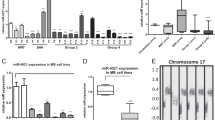Abstract
Medulloblastoma is the most common and a highly malignant pediatric brain tumor located in the cerebellar region of the brain. Medulloblastomas have recently been shown to consist of four distinct molecular subgroups, viz., WNT, SHH, group 3, and group 4. MiR-206, a miRNA first identified as a myomiR due to its enriched expression in skeletal muscle was found to be expressed specifically in the cerebellum, the site of medulloblastoma occurrence. MiR-206 expression was found to be downregulated in medulloblastomas belonging to all the four molecular subgroups as well as in established medulloblastoma cell lines. Further, the expression of murine homolog of miR-206 was also found to be downregulated in SHH subgroup medulloblastomas from the Smo +/+ transgenic mice and the Ptch1 +/− knockout mice. MiR-206 downregulation in all the four medulloblastoma subgroups suggests tumor-suppressive role for miR-206 in medulloblastoma pathogenesis. The effect of miR-206 expression was analyzed in three established medulloblastoma cell lines, viz., Daoy, D425, and D283 belonging to distinct molecular subgroups. Restoration of miR-206 expression to the levels comparable to those in the normal cerebellum, however, was found to be insufficient to inhibit the growth of established medulloblastoma cell lines. OTX2, an oncogenic miR-206 target, overexpressed in all non-SHH medulloblastomas, is known to inhibit myogenic differentiation of medulloblastoma cells. Overexpression of miR-206 was necessary to downregulate OTX2 expression and inhibit growth of medulloblastoma cell lines.




Similar content being viewed by others
References
Adamson DC, Shi Q, Wortham M et al (2010) OTX2 is critical for the maintenance and progression of Shh-independent medulloblastomas. Cancer Res 70:181–191
Aldosari N, Wiltshire RN, Dutra A et al (2002) Comprehensive molecular cytogenetic investigation of chromosomal abnormalities in human medulloblastoma cell lines and xenograft. Neuro Oncol 4:75–85
Ambros V (2004) The functions of animal microRNAs. Nature 431:350–355
Bai RY, Staedtke V, Lidov HG, Eberhart CG, Riggins GJ (2012) OTX2 represses myogenic and neuronal differentiation in medulloblastoma cells. Cancer Res 72:5988–6001
Bourdeaut F, Miquel C, Alapetite C, Roujeau T, Doz F (2011) Medulloblastomas: update on a heterogeneous disease. Curr Opin Oncol 23:630–637
Bunt J, Hasselt NE, Zwijnenburg DA et al (2012) OTX2 directly activates cell cycle genes and inhibits differentiation in medulloblastoma cells. Int J Cancer 131:E21–E32
Chomczynski P, Sacchi N (1987) Single-step method of RNA isolation by acid guanidinium thiocyanate-phenol-chlorofrom extraction. Anal Biochem 162:156–159
Corcoran RB, Scott MP (2001) A mouse model for medulloblastoma and basal cell nevus syndrome. J Neurooncol 53:307–318
Dey J, Dubuc AM, Pedro KD et al (2013) MyoD is a tumor suppressor gene in medulloblastoma. Cancer Res 73:6828–6837
Di Leva G, Croce CM (2013) miRNA profiling of cancer. Curr Opin Genet Dev 23:3–11
Frantz GD, Weimann JM, Levin ME, McConnell SK (1994) Otx1 and Otx2 define layers and regions in developing cerebral cortex and cerebellum. J Neurosci Off J Soc Neurosci 14:5725–5740
Friedman HS, Burger PC, Bigner SH et al (1985) Establishment and characterization of the human medulloblastoma cell line and transplantable xenograft D283 Med. J Neuropathol Exp Neurol 44:592–605
Gokhale A, Kunder R, Goel A et al (2010) Distinctive microRNA signature of medulloblastomas associated with the WNT signaling pathway. J Cancer Res Ther 6:521–529
Hallahan AR, Pritchard JI, Hansen S et al (2004) The SmoA1 mouse model reveals that notch signaling is critical for the growth and survival of sonic hedgehog-induced medulloblastomas. Cancer Res 64:7794–7800
Kool M, Korshunov A, Remke M et al (2012) Molecular subgroups of medulloblastoma: an international meta-analysis of transcriptome, genetic aberrations, and clinical data of WNT, SHH, Group 3, and Group 4 medulloblastomas. Acta Neuropathol 123:473–484
Koutsoulidou A, Mastroyiannopoulos NP, Furling D, Uney JB, Phylactou LA (2011) Expression of miR-1, miR-133a, miR-133b and miR-206 increases during development of human skeletal muscle. BMC Dev Biol 11:34
Kunder R, Jalali R, Sridhar E et al (2013) Real-time PCR assay based on the differential expression of microRNAs and protein-coding genes for molecular classification of formalin-fixed paraffin embedded medulloblastomas. Neuro-Oncology 15:1644–1651
Lucon DR, Rocha Cde S, Craveiro RB et al (2013) Downregulation of 14q32 microRNAs in Primary Human Desmoplastic Medulloblastoma. Front Oncol 3:254
McCarthy JJ (2008) MicroRNA-206: the skeletal muscle-specific myomiR. Biochim Biophys Acta 1779:682–691
Mosmann T (1983) Rapid colorimetric assay for cellular growth and survival:application to proliferation and cytotoxic assays. J Immunol Methods 65:55–63
Olsen L, Klausen M, Helboe L, Nielsen FC, Werge T (2009) MicroRNAs show mutually exclusive expression patterns in the brain of adult male rats. PLoS One 4:e7225
Rosenberg MI, Georges SA, Asawachaicharn A, Analau E, Tapscott SJ (2006) MyoD inhibits Fstl1 and Utrn expression by inducing transcription of miR-206. J Cell Biol 175:77–85
Taylor MD, Northcott PA, Korshunov A et al (2012) Molecular subgroups of medulloblastoma: the current consensus. Acta Neuropathol 123:465–472
Wang R, Hu Y, Song G et al (2012) MiR-206 regulates neural cells proliferation and apoptosis via Otx2. Cell Physiol Biochem 29:381–390
Acknowledgments
We would like to thank the Department of Biotechnology, New Delhi, for the financial support. We thank Dr. Matthew Scott, Stanford School of Medicine, USA, and Dr. James Olson, Fred Hutchinson Cancer Research Centre, USA, for the mouse models of SHH-signaling-driven medulloblastomas. We thank Dr. S. K. Shankar, NIMHANS, Bangalore for the normal human brain tissues.
Conflict of Interest
The authors declare that they have no conflict of interest.
Author information
Authors and Affiliations
Corresponding author
Rights and permissions
About this article
Cite this article
Panwalkar, P., Moiyadi, A., Goel, A. et al. MiR-206, a Cerebellum Enriched miRNA Is Downregulated in All Medulloblastoma Subgroups and Its Overexpression Is Necessary for Growth Inhibition of Medulloblastoma Cells. J Mol Neurosci 56, 673–680 (2015). https://doi.org/10.1007/s12031-015-0548-z
Received:
Accepted:
Published:
Issue Date:
DOI: https://doi.org/10.1007/s12031-015-0548-z




